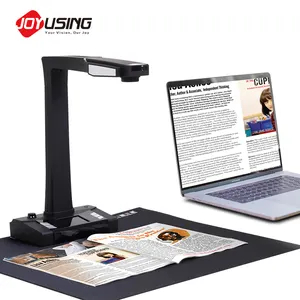(40 products available)

















































































































































A 3D object document camera is used to capture high-resolution images of an object from multiple perspectives to create a digital 3D model. Various types of 3D object document cameras are available.
Students can utilize document cameras to create 3D images of maps, charts, graphs, and other visual aids. This can help students who learn best through visual cues by providing aids they can reference later while taking notes. Cameras with good AI handwriting recognition can take notes in digital formats, which students can also use for note-taking or adding information to existing documents.
Small businesses use 3D cameras to organize physical documents electronically by scanning them to create virtual file systems for easy access and backup. These 3D document cameras can also be used to digitize contracts and other legal paperwork, which lawyers can use to make e-signatures and save them electronically. Furthermore, the availability of object camera apps has made it easy for businesses to edit and share images and videos, which has improved their marketing strategies.
Document cameras are widely used in classrooms, presenting rooms, or training workshops. These cameras aid in the capturing and sharing of 3D images. With the ability to take real-time notes and share presentations and lectures electronically, learning has become a more interactive experience. Some of the camera features that boost implementations in training and learning spaces include the ability to connect to various multimedia and digital devices, laptops, smartboards, and projectors; robust annotation software, high definition, and sound, adjustable and flexible mounts, and remote control access.
The medical field utilizes document cameras for various applications. The ability to store and share 3D images has made possible diagnoses and medical education possible. Surgeons can make informed decisions based on the ability to share and discuss in real time. The camera's ability to connect to electronic medical systems has made it easy to document patient information electronically. Medical training devices integrated with document and object cameras have made it possible to educate medical staff by simulating real-life medical situations.
The legal field depends on accurate documentation of evidence, case files, and other important papers. With 3D document cameras, lawyers, and legal assistants can easily scan and digitize documents for electronic filing systems. High-resolution imaging helps capture evidence such as accident scenes, injuries, and other vital details in 3D, making presentation in court more effective. Cameras connected to electronic legal document systems aid in the collaboration and sharing of documents through e-signatures.
Factories and workshops use 3D object cameras in moving assembly lines to monitor production processes. Adapting camera systems integrated with AI technology helps in the quality control of finished products. Instant alerts and feedback allow for timely corrections to minimize losses. Additionally, camera applications that allow for the sharing of 3D images play an important role in team training and ensuring safety procedures are followed.
When sourcing document cameras, buyers should select models that have durable and flexible structures. For instance, some cameras have a gooseneck design that is easy to adjust and sturdy document arms that support the camera head. Additionally, vendors may find that document cameras with a foldable design are more portable and easy to store compared to fixed models.
To get a high-quality picture, buyers should settle for cameras with higher mega pixels. Buyers can find document cameras with a range of 1 to 20 mega pixels. However, 12 to 20 mega pixels cameras are better suited for high-resolution image tasks such as scanning objects. Buyers should also check the camera’s frame per second specification for video documentation. Between 20 to 60 frames per second is ideal for smooth video playback.
Document cameras come with various zoom capabilities. Some have a digital zoom that magnifies images at an average of 4x magnification. On the other hand, some models have a more sophisticated optical zoom that can magnify images up to 600x. When shopping for document cameras, buyers should consider the zoom model that suits their tasks.
These cameras are equipped with different types of sensors, including CMOS and CCD. While both sensors capture high-quality images, CMOS sensors give more crisp and clear images. Generally, document cameras with CCD sensors cost more than those with CMOS sensors.
Connection options are crucial when connecting the camera to a PC or projector. Most document cameras have a USB 2.0 and USB 3.0 cable connection. Some models support both cable and wireless options using WI-FI or Bluetooth connectivity. Buyers should choose the most convenient connection option that suits them.
Q: What materials can be scanned with a document camera?
A: A 3D object document camera can scan a wide variety of materials, including paper, fabric, plastic, and light metals. The actual materials that can be scanned will depend on the capabilities of the camera. Checking the camera specs can help buyers determine what items will work with the camera.
Q: How long does it take to scan an object?
A: The scanning time will depend on the size of the object and the resolution settings. Higher resolution scans will take longer than lower resolution scans.
Q: What type of software is required to use a 3D camera?
A: 3D document cameras may require specific drivers or software to function. These items are usually included with the camera. In some cases, users may need to download the software from the manufacturer’s website.
Q: What is the maximum scanning resolution?
A: The maximum resolution will vary from model to model. Always check the user manual or product specifications for details on scanning resolution.
Q: What type of objects can be scanned?
A: Anything that is not too heavy or too small for the camera to handle. The user manual will have more details on object size and weight limits.